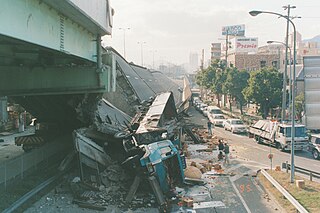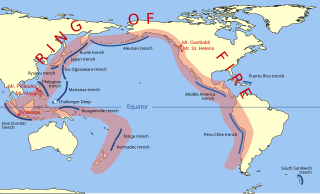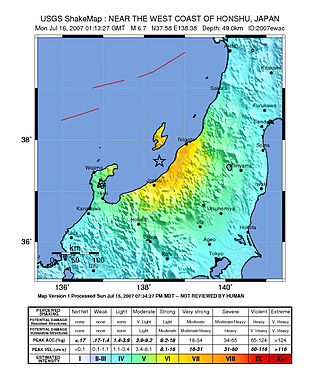
An earthquake – also called a quake, tremor, or temblor – is the shaking of the Earth's surface resulting from a sudden release of energy in the lithosphere that creates seismic waves. Earthquakes can range in intensity, from those so weak they cannot be felt, to those violent enough to propel objects and people into the air, damage critical infrastructure, and wreak destruction across entire cities. The seismic activity of an area is the frequency, type, and size of earthquakes experienced over a particular time. The seismicity at a particular location in the Earth is the average rate of seismic energy release per unit volume.

Subduction is a geological process in which the oceanic lithosphere and some continental lithosphere is recycled into the Earth's mantle at the convergent boundaries between tectonic plates. Where one tectonic plate converges with a second plate, the heavier plate dives beneath the other and sinks into the mantle. A region where this process occurs is known as a subduction zone, and its surface expression is known as an arc-trench complex. The process of subduction has created most of the Earth's continental crust. Rates of subduction are typically measured in centimeters per year, with rates of convergence as high as 11 cm/year.

The Great Hanshin Earthquake occurred on January 17, 1995, at 05:46:53 JST in the southern part of Hyōgo Prefecture, Japan, including the region known as Hanshin. It measured 6.9 on the moment magnitude scale and had a maximum intensity of 7 on the JMA Seismic Intensity Scale. The tremors lasted for approximately 20 seconds. The focus of the earthquake was located 17 km beneath its epicenter, on the northern end of Awaji Island, 20 km away from the center of the city of Kobe.

The Ring of Fire is a tectonic belt of volcanoes and earthquakes.

Parkfield is an unincorporated community in Monterey County, California. It is located on Little Cholame Creek 21 miles (34 km) east of Bradley, at an elevation of 1,529 feet (466 m). As of 2007, road signs announce the population as 18.
Megathrust earthquakes occur at convergent plate boundaries, where one tectonic plate is forced underneath another. The earthquakes are caused by slip along the thrust fault that forms the contact between the two plates. These interplate earthquakes are the planet's most powerful, with moment magnitudes (Mw) that can exceed 9.0. Since 1900, all earthquakes of magnitude 9.0 or greater have been megathrust earthquakes.

The Great Sumatran fault, also known as Semangko fault, is a large strike-slip fault running the entire length of the island of Sumatra. This Indonesian island is located in a highly seismic area of the world, including a subduction zone off the west coast of the island.
The 1938 Banda Sea earthquake occurred on February 2 at 04:04 local time with an estimated magnitude of 8.5-8.6 on the moment magnitude scale. Shaking was intense with an assigned Rossi–Forel intensity of VII and intensity of VI (Strong) on the Modified Mercalli intensity scale. This oblique-slip event generated a destructive tsunami of up to 1.5 metres in the Banda Sea region, but there were no deaths.

The Chūetsu offshore earthquake) was a powerful magnitude 6.6 earthquake that occurred 10:13 local time on July 16, 2007, in the northwest Niigata region of Japan. The earthquake, which occurred at a previously unknown offshore fault shook Niigata and neighbouring prefectures. The city of Kashiwazaki and the villages of Iizuna and Kariwa registered the highest seismic intensity of a strong 6 on Japan's shindo scale, and the quake was felt as far away as Tokyo. Eleven deaths and at least 1,000 injuries were reported, and 342 buildings were completely destroyed, mostly older wooden structures. Prime Minister Shinzō Abe broke off from his election campaign to visit Kashiwazaki and promised to "make every effort towards rescue and also to restore services such as gas and electricity".
The February 1998 Afghanistan earthquake occurred at near the Afghanistan-Tajikistan border. The strike-slip shock had a moment magnitude of 5.9 and a maximum Mercalli intensity of VIII (Severe). With several thousand dead and hundreds injured, the event's effects were considered extreme by the National Geophysical Data Center. It was felt at Tashkent and Dushanbe, and aftershocks continued for the next seven days.
The 2003 Boumerdès earthquake occurred on May 21 at in northern Algeria. The shock had a moment magnitude of 6.8 and a maximum Mercalli intensity of X (Extreme). The epicentre of the earthquake was located near the town of Thénia in Boumerdès Province, approximately 60 km east of the capital Algiers. The quake was the strongest to hit Algeria in more than twenty years – since 1980, when a magnitude 7.1 earthquake resulted in at least 2,633 deaths.

The 1978 Miyagi earthquake occurred at 17:14 local time on 12 June. The epicentre was offshore of Miyagi Prefecture, Japan. It had a surface-wave magnitude of 7.7, JMA magnitude 7.4, and triggered a small tsunami. The earthquake reached a maximum intensity of Shindo 5 in Sendai and caused 28 deaths and 1,325 injuries.
The 1971 Bingöl earthquake was a 6.6–6.7 earthquake that occurred at on 22 May. It had a surface-wave magnitude of 6.9 and a maximum intensity of IX (Violent) on the Mercalli intensity scale, killing 755–1,000 people. Bingöl was largely destroyed, as well as many houses in the nearby Bingöl plain. Surface displacement of 38 km (24 mi) and various other surficial effects were directly caused by the earthquake.
The 1996 Biak earthquake, or the Irian Jaya earthquake, occurred on 17 February at near Biak Island, Indonesia. The earthquake, which occurred on the New Guinea Trench, had a moment magnitude of 8.2 and a maximum Mercalli intensity of IX (Violent). The run-up height of the generated tsunami reached 7.7 m (25 ft). The disaster left at least 108 people dead, 423 injured, and 58 missing. It damaged or destroyed 5,043 houses which subsequently made another 10,000 homeless. At Korim, 187 houses were destroyed. Various countries and organizations provided aid and relief in the aftermath of the earthquake.
The 2002 Sumatra earthquake occurred at 01:26 UTC on 2 November. It had a magnitude of 7.4 on the moment magnitude scale with an epicenter just north of Simeulue island and caused three deaths. This earthquake is regarded as a foreshock of the 2004 Indian Ocean earthquake, which had an epicenter about 60 km to the northwest.
The 1906 Aleutian Islands earthquake occurred at 00:11 UTC on August 17. It had an estimated seismic moment of 3.8 x 1028 dyn cm−1, equivalent to a magnitude of 8.35 on the moment magnitude scale. This earthquake was followed thirty minutes later by the 1906 Valparaíso earthquake in Chile, but the two events are not thought to be linked. Due to the remote location, there are no reports of damage associated with this earthquake. A transpacific tsunami reported from Japan and Hawaii was triggered by the Chilean event, rather than the Aleutian Islands earthquake.
The 2013 Saravan earthquake occurred with a moment magnitude of 7.7 at 15:14 pm IRDT (UTC+4:30) on 16 April. The shock struck a mountainous area between the cities of Saravan and Khash in Sistan and Baluchestan Province, Iran, close to the border with Pakistan, with a duration of about 25 seconds. The earthquake occurred at an intermediate depth in the Arabian plate lithosphere, near the boundary between the subducting Arabian plate and the overriding Eurasian plate at a depth of about 80 km.
The February 2001 El Salvador earthquake occurred with a moment magnitude of 6.6 on 13 February at 14:22:05 UTC. The epicentre was 15 miles (30 km) E of San Salvador, El Salvador, at a depth of 10 km (6.2 mi). At least 315 people were killed, 3,399 were injured, and extensive damage affected the area. Another 16,752 homes were damaged and 44,759 destroyed. The most severe damage occurred in the San Juan Tepezontes-San Vicente-Cojutepeque area, though it was felt throughout the country and in neighboring Guatemala and Honduras. Landslides occurred in many areas of El Salvador.

On 21 July 2017, a large earthquake measuring 6.6 on the moment magnitude scale struck right near Bodrum, a popular town of tourism in Turkey, killing 2 and injuring hundreds. Mostly referenced as the 2017 Bodrum–Kos earthquake, this earthquake generated a tsunami which was one of the largest tsunamis in the Mediterranean Sea region.

Jirisan (Korean: 지리산) is a 2021 South Korean television series starring Jun Ji-hyun and Ju Ji-hoon. It is named after the eponymous mountain in South Korea and has been promoted as "tvN's 15th Anniversary Special Drama". It premiered on tvN on October 23 to December 12, 2021, and aired every Saturday and Sunday at 21:00 (KST). The series is available for streaming on iQIYI worldwide, and on Viki and Netflix in selected territories.










